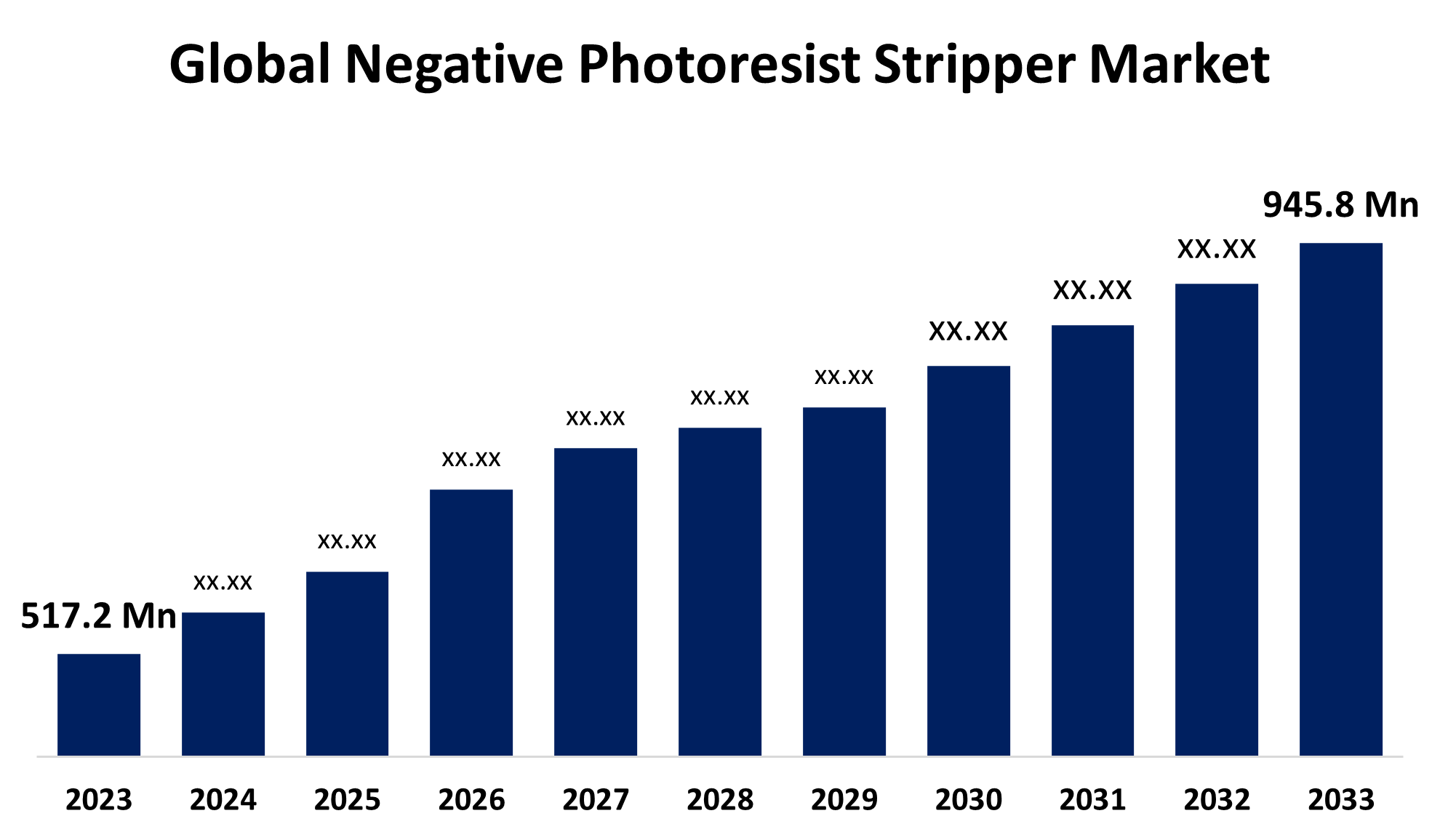Global Negative Photoresist Stripper Market Size, Share, and COVID-19 Impact Analysis, By Product Type (Solvent-Based, Aqueous-Based, and Others), By Application (Semiconductor Manufacturing, MEMS, LCDs, and Others), and By Region (North America, Europe, Asia-Pacific, Latin America, Middle East, and Africa), Analysis and Forecast 2023 - 2033.
Industry: Chemicals & MaterialsGlobal Negative Photoresist Stripper Market Insights Forecasts to 2033
- The Global Negative Photoresist Stripper Market Size was estimated at USD 517.2 Million in 2023
- The Market Size is Expected to Grow at a CAGR of around 6.22% from 2023 to 2033
- The Worldwide Negative Photoresist Stripper Market Size is Expected to Reach USD 945.8 Million by 2033
- Europe is expected to grow the fastest during the forecast period.

Get more details on this report -
The Global Negative Photoresist Stripper Market Size is expected to cross USD 945.8 Million by 2033, growing at a CAGR of 6.22% from 2023 to 2033.
Market Overview
The global negative photoresist stripper market is the industry that manufactures, distributes, and applies chemical solutions to remove negative photoresists from semiconductor wafers, printed circuit boards (PCBs), and microelectromechanical systems (MEMS). Negative photoresist strippers are necessary for the photolithography process because they help remove unwanted photoresist layers without damaging the underlying substrate. The semiconductor industry's continued growth represents one of the most significant prospects in the negative photoresist remover market. As the demand for improved electrical devices and semiconductor components grows, the necessity for efficient and precise photoresist stripping solutions becomes increasingly important. Innovations in semiconductor production processes, such as the development of new materials and architectures, provide opportunities for manufacturers to produce specialized stripping solutions that are specific to these improvements. Furthermore, the increased emphasis on sustainability and eco-friendly manufacturing techniques creates chances for creating and marketing ecologically friendly stripping products.
Report Coverage
This research report categorizes the negative photoresist stripper market based on various segments and regions forecasts revenue growth and analyzes trends in each submarket. The report analyses the key growth drivers, opportunities, and challenges influencing the negative photoresist stripper market. Recent market developments and competitive strategies such as expansion, type launch, development, partnership, merger, and acquisition have been included to draw the competitive landscape in the market. The report strategically identifies and profiles the key market players and analyses their core competencies in each sub-segment of the negative photoresist stripper market.
Global Negative Photoresist Stripper Market Report Coverage
| Report Coverage | Details |
|---|---|
| Base Year: | 2023 |
| Market Size in 2023: | USD 517.2 Million |
| Forecast Period: | 2023-2033 |
| Forecast Period CAGR 2023-2033 : | 6.22% |
| 2033 Value Projection: | USD 945.8 Million |
| Historical Data for: | 2019-2022 |
| No. of Pages: | 214 |
| Tables, Charts & Figures: | 110 |
| Segments covered: | By Product Type, By Application, By Region |
| Companies covered:: | JSR Corporation, BASF SE, Honeywell International Inc., Tokyo Ohka Kogyo Co., Ltd., DuPont de Nemours, Inc., Sumitomo Chemical Co., Ltd., Fujifilm Holdings Corporation, Versum Materials, Inc., MicroChemicals GmbH, Dow Inc., Shin-Etsu Chemical Co., Ltd., Avantor, Inc., LG Chem Ltd., Technic Inc., Merck KGaA, and other key players |
| Pitfalls & Challenges: | COVID-19 Empact, Challenge, Future, Growth, & Analysis |
Get more details on this report -
Driving Factors
The continued advancement of semiconductor manufacturing technologies is a primary driver of the negative photoresist stripper market's growth. Modern electronic devices like smartphones and high-performance computer systems are largely based on the semiconductor industry. The demand for smaller, more efficient, and powerful semiconductor devices will increase, as will the requirement for efficient and effective photoresist stripping solutions. These strippers are critical to the quality and performance of semiconductor wafers, notably in removing photoresist layers without destroying the underlying materials. The market is also seeing a trend of specialization, with players creating stripping solutions for specific applications and materials. This contains advanced formulations intended for MEMS, LCDs, and other specialist semiconductor devices. Companies that focus on niche markets and address particular problems in photoresist stripping might differentiate themselves and capture market share in specific niches. This approach is especially important in an industry marked by rapid technical breakthroughs and the ongoing emergence of new applications and materials.
Restraining Factors
However, the negative photoresist stripper market confronts various challenges. One of the key obstacles is the strict environmental rules that control the use and disposal of chemical strippers. Traditional solvent-based strippers, while effective, represent major environmental and health concerns, necessitating enhanced regulatory oversight and limits. Manufacturers must invest in R&D to produce environmentally friendly alternatives that meet these rules while keeping performance levels.
Market Segmentation
The negative photoresist stripper market share is classified into product type and application.
- The solvent-based segment held the greatest share in 2023 and is anticipated to grow at a significant CAGR during the forecast period.
Based on the product type, the negative photoresist stripper market is divided into solvent-based, aqueous-based, and others. Among these, the solvent-based segment held the greatest share in 2023 and is anticipated to grow at a significant CAGR during the forecast period. Solvent-based negative photoresist strippers use organic solvents to dissolve photoresist compounds. They are well-known for their powerful stripping capabilities and are widely employed in high-performance applications. Additionally, the use of solvents poses environmental and safety problems, necessitating increasing regulatory oversight and the development of greener alternatives.
- The semiconductor manufacturing segment accounted for the majority of the share in 2023 and is estimated to grow at a remarkable CAGR during the projected timeframe.
Based on the application, the negative photoresist stripper market is divided into semiconductor manufacturing, mems, LCDs, and others. Among these, the semiconductor manufacturing segment accounted for the majority of the share in 2023 and is estimated to grow at a remarkable CAGR during the projected timeframe. This is due to the growing complexity and downsizing of semiconductor components, necessitating precise and efficient photoresist removal techniques. Negative photoresist strippers are critical in semiconductor fabrication because they provide residue-free cleaning without destroying sensitive structures, making them an important component in the production of integrated circuits (ICs), microprocessors, memory chips, and other semiconductor devices.
Regional Segment Analysis of the Negative Photoresist Stripper Market
- North America (U.S., Canada, Mexico)
- Europe (Germany, France, U.K., Italy, Spain, Rest of Europe)
- Asia-Pacific (China, Japan, India, Rest of APAC)
- South America (Brazil and the Rest of South America)
- The Middle East and Africa (UAE, South Africa, Rest of MEA)
North America is anticipated to hold the largest share of the negative photoresist stripper market over the predicted timeframe.

Get more details on this report -
North America is anticipated to hold the largest share of the negative photoresist stripper market over the predicted timeframe. The region's sophisticated technological infrastructure and major investments in R&D are driving the rise. The United States, in particular, is a prominent player in the worldwide semiconductor sector, with several leading semiconductor firms and research organizations. The region's emphasis on research and the development of cutting-edge semiconductor technology bolsters demand for innovative photoresist stripping solutions. The increasing usage of MEMS technology, as well as the growing need for high-performance electronic devices in a variety of industries, are driving market expansion in North America.
Europe is expected to grow at the fastest CAGR growth of the negative photoresist stripper market during the forecast period. Leading semiconductor businesses in the region include Infineon Technologies, NXP Semiconductors, and STMicroelectronics, which drives need for innovative photoresist stripping solutions. Furthermore, rising demand for consumer devices such as smartphones, laptops, and tablets is driving semiconductor production, increasing the need for efficient photoresist strippers. The growing adoption of energy-efficient lighting solutions, such as LED technology, also helps to drive market expansion, as the semiconductor processes used in LED manufacture necessitate accurate stripping solutions.
Competitive Analysis:
The report offers the appropriate analysis of the key organizations/companies involved within the negative photoresist stripper market along with a comparative evaluation primarily based on their type of offering, business overviews, geographic presence, enterprise strategies, segment market share, and SWOT analysis. The report also provides an elaborative analysis focusing on the current news and developments of the companies, which includes type development, innovations, joint ventures, partnerships, mergers & acquisitions, strategic alliances, and others. This allows for the evaluation of the overall competition within the market.
List of Key Companies
- JSR Corporation
- BASF SE
- Honeywell International Inc.
- Tokyo Ohka Kogyo Co., Ltd.
- DuPont de Nemours, Inc.
- Sumitomo Chemical Co., Ltd.
- Fujifilm Holdings Corporation
- Versum Materials, Inc.
- MicroChemicals GmbH
- Dow Inc.
- Shin-Etsu Chemical Co., Ltd.
- Avantor, Inc.
- LG Chem Ltd.
- Technic Inc.
- Merck KGaA
- Others
Key Target Audience
- Market Players
- Investors
- End-users
- Government Authorities
- Consulting And Research Firm
- Venture capitalists
- Value-Added Resellers (VARs)
Market Segment
This study forecasts revenue at global, regional, and country levels from 2023 to 2033. Spherical Insights has segmented the negative photoresist stripper market based on the below-mentioned segments:
Global Negative Photoresist Stripper Market, By Product Type
- Solvent-Based
- Aqueous-Based
- Others
Global Negative Photoresist Stripper Market, By Application
- Semiconductor Manufacturing
- MEMS
- LCDs
- Others
Global Negative Photoresist Stripper Market, By Regional Analysis
- North America
- US
- Canada
- Mexico
- Europe
- Germany
- UK
- France
- Italy
- Spain
- Russia
- Rest of Europe
- Asia Pacific
- China
- Japan
- India
- South Korea
- Australia
- Rest of Asia Pacific
- South America
- Brazil
- Argentina
- Rest of South America
- Middle East & Africa
- UAE
- Saudi Arabia
- Qatar
- South Africa
- Rest of the Middle East & Africa
Frequently Asked Questions (FAQ)
-
What is the CAGR of the negative photoresist stripper market over the forecast period?The negative photoresist stripper market is projected to expand at a CAGR of 6.22% during the forecast period.
-
What is the market size of the negative photoresist stripper market?The Global Negative Photoresist Stripper Market Size is Expected to Grow from USD 517.2 Million in 2023 to USD 945.8 Million by 2033, at a CAGR of 6.22% during the forecast period 2023-2033
-
Which region holds the largest share of the negative photoresist stripper market?North America is anticipated to hold the largest share of the negative photoresist stripper market over the predicted timeframe.
Need help to buy this report?